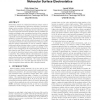Free Online Productivity Tools
i2Speak
i2Symbol
i2OCR
iTex2Img
iWeb2Print
iWeb2Shot
i2Type
iPdf2Split
iPdf2Merge
i2Bopomofo
i2Arabic
i2Style
i2Image
i2PDF
iLatex2Rtf
Sci2ools
ICCAD
2006
IEEE
2006
IEEE
A spectrally accurate integral equation solver for molecular surface electrostatics
Electrostatic analysis of complicated molecular surfaces arises in a number of nanotechnology applications including: biomolecule design, carbon nanotube simulation, and molecular electron transport. Molecular surfaces are typically smooth, without the corners common in electrical interconnect problems, and are candidates for methods with higher order convergence than that of the commonly used flat panel methods. In this paper we describe and demonstrate a spectrally accurate approach for analyzing molecular surfaces described by a collection of surface points. The method is a synthesis of several techniques, and starts by using least squares to fit a high order spherical harmonic surface representation to the given points. Then this analytic representation is used to construct a differentiable map from the molecular suface to a cube, an orthogonal basis is generated on the rectangular cube surfaces, and a change of variables is used to desingularize the required integrals of produc...
Hardware | ICCAD 2006 | Molecular Electron Transport | Molecular Surfaces Arises | Rectangular Cube Surfaces |
| Added | 16 Mar 2010 |
| Updated | 16 Mar 2010 |
| Type | Conference |
| Year | 2006 |
| Where | ICCAD |
| Authors | Shih-Hsien Kuo, Jacob White |
Comments (0)

